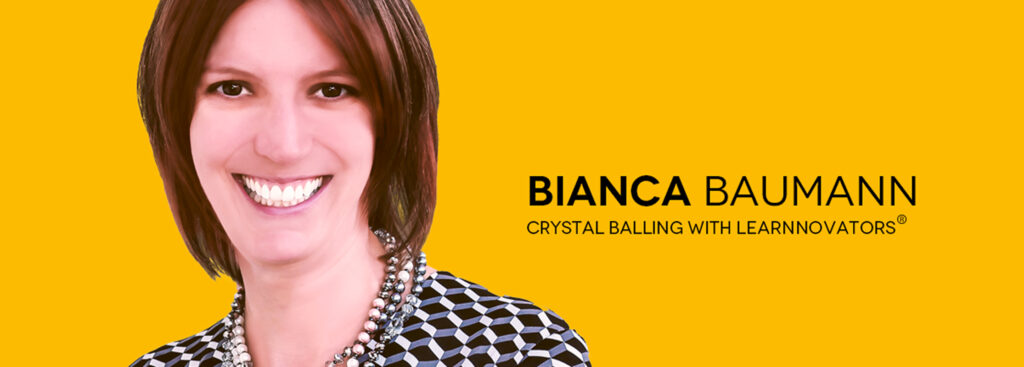BIANCA BAUMANN – CRYSTAL BALLING WITH LEARNNOVATORS
ABOUT BIANCA BAUMANN:
Bianca Baumann is a Senior Learning Strategist and Director, Learning Experience at GP Strategies, Global Innovation, Research & Development. Over time, she has developed processes and methodologies to help organizations meet their growth and revenue targets with the help of innovative L&D approaches, including digital transformations, onboarding and reskilling programs. She has spearheaded multiple projects in the marketing, automotive, financial and events industries, creating award-winning programs along the way.
Bianca shares her expertise through her blog and at global conferences, highlighting the importance of including disciplines outside L&D to help organizations build the workforce of the future. She teaches courses as part of the Learning Experience Design Certificate at OISE, and has published the eBook “The Little Black Book of Marketing and L&D”, a practical guide that helps integrate proven marketing techniques into L&D.
ABOUT THIS INTERVIEW SERIES:
Crystal Balling with Learnnovators is a thought-provoking interview series that attempts to gaze into the future of e-learning. It comprises stimulating discussions with industry experts and product evangelists on emerging trends in the learning landscape.
Join us on this exciting journey as we engage with thought leaders and learning innovators to see what the future of our industry looks like.
THE INTERVIEW:
1. LEARNNOVATORS: We are great fans of you, Bianca. You are an expert learning strategist who has been continuously inspiring the world to design better and meaningful learning experiences. It’s an honor to have you here today to discuss the past, present, and the future around these topics.
You are considered a thought leader at the intersection of marketing and L&D. You have been trying to help the community better understand the power of marketing and ways to bring that into learning. What does your experience say about the changing nature of workplace learning from the perspective of marketing? What are the most pressing learning challenges corporations are facing today that are influencing L&D to re-imagine itself?
BIANCA BAUMANN: I think the most obvious change to our workplace is that, for most people, it is also our home, and we are dealing with lots of competing priorities while shifting to a world in which we connect virtually with everyone and everything.
Traditional face-to-face training sessions are converted to virtual sessions, often with little thought towards creating an engaging learner experience. Many organizations shifted to e-learning modules and videos to train their staff. What we are missing in the mix though is the informal and social learning aspect that often drives around 70% of our learning experiences.
Either way, from a marketing perspective, I haven’t seen how we effectively communicate with learners about these changes, how we excite them, and how we make them aware of new offerings. Apart from a standard, boring email of course! Teaser videos or intranet banners are just two ideas on how to draw attention to what’s new and excite learners.
Aside from the changing workplace, workers are asked to do more with less. Longer hours, higher workloads while at the same time taking care of the kids and pets, cooking lunch and trying to make the next meeting… This situation doesn’t leave time for workers to learn something new, to reflect, or to connect with their co-workers on non-work-related issues. And if training is made mandatory, there is a really good chance that workers simply have to extend their workdays to fit it all in.
This new situation really requires L&D to think more about learning in the flow of work and integrate learning opportunities throughout their days. Thinking like a marketer here, learning campaigns are an excellent way to engage learners on a regular basis, push content, allow learners to pull content, and nudge them on a regular basis. Instead of hour-long sessions or long-winded e-learning modules, we need to find ways to drop small content pieces over time, allow for meaningful connections and most important of all, reflection time.
2. LEARNNOVATORS: You say, “My focus is around marketing and L&D (as you probably know!), not so much about how to market learning, but more around how to bring marketing techniques into L&D.” Looking back, how has your journey, of helping non-marketing people understand more about the possibilities of marketing, been so far? What have been some of the challenges and inspirations? What would be your message to learning professionals, especially those who are not well-versed with the nuances of marketing, to bring the best of this channel into their learning and performance support solutions?
BIANCA BAUMANN: It’s been a great experience for sure with lots of positive feedback and success stories from L&D professionals that implemented marketing into their L&D programs. There also have been a number of people who don’t truly see and understand the connection. I assume that these people are often worried about their jobs and that marketing and communication might take over. To these people, I can only say that if we don’t look outside of L&D, we will lose our jobs! We need to be open to other areas within the business, leverage processes and tools, and be more down to earth, or “down to learner”. It’s about creating learning experiences that reflect what learners would expect in other areas of their lives. We live in a fast-paced world where technology is our constant companion. I’m not saying that L&D needs to be all about technology. On the contrary, technology should simply be an enabler for our learning experiences but starting with the learner and their experiences in mind when we design, is a no brainer.
The biggest challenge is certainly that when people hear marketing, they think about the actual promotion of training programs. This aspect is most certainly very important and often overlooked. But I like to take it one step further and integrate marketing thinking into our design. This means, working with learner personas, creating content strategies, using the marketing funnel as a starting point for learner journeys, and of course learning campaigns to create multi-touchpoint, blended learning solutions. There are a lot of options to learn more about how to integrate marketing into L&D. There is my eBook (if I can self-promote here real quick!), there are people like Mike Taylor and Ashley Sinclair that live and breathe marketing for L&D. Follow them on LinkedIn and Twitter. I’m also a big fan of the Content Marketing Institute and Marketing Profs.
3. LEARNNOVATORS: Like many out there (including Jane Hart), we, too, believe that the role and skills of an instructional designer need to evolve and cannot remain static in this new world of workplace learning. For this, there’s a lot that we can, and need to, borrow from other spheres of life (including marketing, of course) to make the learning experiences that we design truly memorable for people. According to Heather McGowan, the future may include 15 or more jobs per person, and this demands a shift from ‘learning to do’ to ‘learning in order to continuously learn and adapt.’ An interesting analogy she quotes here is ‘learning to master a single instrument’ versus ‘learning to conduct an orchestra.’ From your own experiences, what do you think are the ‘new roles’ and ‘extended skillsets’ of a new age workplace learning designer? What have been your challenges, if any, with respect to this evolution?
BIANCA BAUMANN: This is such a great question! Let me start answering this question from the learner perspective first. Traditionally, learners simply consumed learning. Today, learners are not only consumers, but they are collaborators, curators, moderators, contributors and creators. That adds a whole new perspective to how L&D tackles these new roles, designs learning and offers learning opportunities. It is not enough anymore to be a sound Instructional Designer in the traditional sense. Training isn’t a stand-alone element anymore. We are shifting to a learning ecosystem in which informal learning opportunities become more and more important. An environment in which learners search the internet, curate their own resources and connect with others outside the organization to find the answers they need. Yet, our L&D departments often don’t recognize or reward this behaviour. The traditional Instructional Designer thinks that only the content that sits on the LMS and can be tracked there is relevant. We’ve long passed this notion, but many L&D departments haven’t caught on yet.
We need to become familiar with curation techniques, we need to be comfortable with technology outside the LMS, and we have to truly start putting the learner at the centre of everything we do. Learner first, then content. Not the other way around.
L&D professionals also have to come off their soap box. We don’t “own” training and learning. Everyone within the organization can support it, we simply are the messenger and enabler. So, dip into your organization, leverage others to help you build a connected, knowledge organization.
Lastly, we have to move away from training for a specific role and train towards skills instead. I like to imagine this as building with LEGO. Each building block is another skill, and every worker will build a different shape with their own LEGO blocks, creating connected teams across organizations, and each worker focusing on different skills. This means, we have to be aware of what skills actually exist in our organization, and how to bring people together to create the best possible team for a task. That’s not an easy undertaking, but a necessary one if we want to retain talent and offer them opportunities to learn and grow. And of course, to help achieve organizational goals and objectives.
4. LEARNNOVATORS: According to you, content that doesn’t align with what learners need, let alone when they need it, is the unfortunate truth in today’s L&D landscape. In this context, we are reminded of this thought by the late Joe H. Harless: “Inside every fat course, there’s a thin job aid crying to get out.” We agree with this idea, and believe that training is NOT always the answer. Sending employees ‘away from work’ to take a course is not the right solution in many cases, but bringing learning/support ‘into the flow-of-work’ is. In fact, there have been instances where effective job-aids and other ‘non-course alternatives’ helped us replace courses entirely. In this context, we believe it is high time that we think beyond e-learning to performance support solutions that really help people in their moment of need. What are your suggestions for learning designers to ensure their learners get exactly what they need when they need it?
BIANCA BAUMANN: The first step is to truly understand what it is they need. This sounds simple (and it is), but most L&D professionals still start with content first without considering what the learner needs, what their day to day looks like, what they see, hear, do, and most important of all, think and feel. I never understood why we take emotions out of everything we do. I’m no expert in brain-based learning, but I would argue that if we understand what motivates someone, we have a “way in”, we can design for them, we can get them excited and have their buy-in.
That being said, learner personas are the way to go. There are many voices out there that do not agree with the concept of learner personas, arguing that it still doesn’t allow us to personalize learning for every single person. And I agree with that, but these people are missing the point! Learner personas are a vehicle for L&D professionals to think differently, to put the learner first. Even if we won’t be able to create a 100% personalized experience, personas still help to get us much closer to the truth than a high-level target audience analysis, or even worse, a content gap analysis without even thinking about the audience ever would.
Once I put myself into the learners’ shoes and understand their work, work processes and the feelings that go along with these, I can map out content that will help support their performance in the moment of need. The 5 Moments of Need model is fantastic to think about performance support, and I regularly use it when I map out learner journeys.
5. LEARNNOVATORS: We are great fans of your book “Little Black Book of Marketing and L&D.” Many have hailed the book as a practical guide that helps one integrate many of the proven marketing techniques into L&D. What prompted you to write the book? How do you think this book has been able to influence and guide the learning community so far? And, if you were to give our readers one key take-away from the book, what would that be?
BIANCA BAUMANN: When I first started to think about how marketing and L&D connect, I used my website to blog about these ideas. I wasn’t sure if I was onto something, or if this was a total shot in the dark. It certainly took a number of years to get acknowledged. Once I had a bit of traction and feedback from trusted advisors and friends in my personal learning network, I decided to share my thoughts in a compact and actionable format for everyone to download for free. The goal was to help move L&D out of the current rut, push the envelope, think differently and be better!
Once it was published, more and more voices came to light that also talked about marketing and L&D. It still is somewhat of a niche, but I receive positive feedback on a regular basis from people that leveraged the e-book to rethink a new program they rolled out, or how it helped them have critical conversations with their colleagues and stakeholders about the state of L&D.
One main takeaway from the e-book is that you can take content you already have and create a learning campaign-based approach without breaking the bank! Most of the time, we already have the tools we need available to us! Don’t be afraid, try it out. It’s easier than it sounds!
6. LEARNNOVATORS: It is thought-provoking to hear you say, “Our programs consist of lots of controllable elements; let’s consider them to bring change to what we do every day.” It is great to see you on this inspiring journey to help drive change in how people learn at work. Like you, we too are excited to visualize the future of learning; it looks very bright. What are the trends that will shape the future of workplace learning in 2021 and beyond? And what is your vision for the L&D community?
BIANCA BAUMANN: I truly hope that the shift to working from home has a long-lasting effect on how organizations let employees learn as well. And I just realized I used the term “let learn” like it is something we can control! Learning happens all day every day and doesn’t need someone to look over a worker’s shoulder to make sure it happens. Anyway, instead of being descriptive about what needs to be learnt, let learners explore what they are interested in, and allow outside resources in. Just because it can’t be tracked on your LMS, doesn’t mean your employees aren’t learning. I do understand the need for compliance training and tracking around that. But I’m talking about re- and upskilling opportunities. I’m talking about creating learning moments that will strengthen not just workers’ knowledge, but improve their performance, offering them tools they need to be successful. Build these into the flow of work, curate content from other sources, and create networks and communities.
Let go of the controlling L&D mindset and guide learners instead. Use data wherever possible to make decisions about learners’ needs and make it a habit to use data on a regular basis to check-in and ensure that what you are offering is still relevant.
I’m envisioning organizations that leverage all of their internal knowledge to create a learning culture everyone is proud of. As mentioned earlier, L&D has to come off its soapbox and become the connector within organizations that bring the right people and right knowledge to workers that need it. We need to move away from role-based learning to skill-based learning to allow employees to grow and expand their horizons, which will allow organizations to stay competitive.
LEARNNOVATORS: Before we sign off, we thank you so much for your time today, Bianca. We’ve had an amazing time reading your insights and have had many valuable takeaways. We’ll take these learnings to foster our commitment to practice and promote continuous learning and innovation at work. We eagerly look forward to collaborating with you on some exciting initiatives in future. Thank you!






